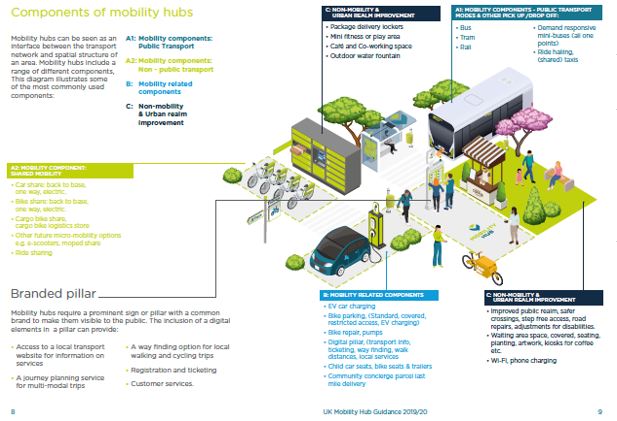Mobility hubs provide a focal point in the transport network that seamlessly integrates different modes of transport, multi-modal supportive infrastructure, and turn spaces into places. It is designed and spatially organised in a way to facilitate access to transport modes and easy transfer between the modes, from rail, to buses, shared cars, shared bikes, and/or shared e-scooters, ride-hailing/shared taxis. Mobility hubs increase the inherent value of every single transport mode connected to the hub. As a result, sustainable transport services are viewed as attractive travel options, as an alternative to private car use.

Components of mobility hubs. Source: https://como.org.uk/wp-content/uploads/2019/10/Mobility-Hub-Guide-241019-final.pdf
Mobility hubs provide as well different sort of facilities such as shopping and catering facilities, delivery or pick-up points, bike repair points etc. The more activities are in a hub, the better as it creates a sense of place. Mobility hubs should be planned with public transport as backbone. They can be distributed throughout urban, suburban and rural areas to enable access to sustainable transport options to fit individual users needs.
There are different types of mobility hubs based on scale:
- Large urban mobility hubs: large interchange hubs or city hubs such as central train stations and public transport interchanges, generally located in dense urban areas, with high passenger numbers.
- Smaller urban mobility hubs: interchange hubs or linking hubs, linking residents/businesses in surrounding areas to core network service.
- Suburban Mobility hubs: linking suburban areas with core centers and core network services. They are usually located in lower density areas where private car ownership and use is higher.
- Smaller or rural proximity hubs: in towns and villages where private car ownership and use is high.
Mobility hubs need to be adapted to the setting in terms of purpose and scale, for instance, rail hubs will offer more space for public transport and bikes (shared or not), shopping facilities etc. while small proximity hubs will offer on top of public transport provision greater choices of flexible mobility (shared cars, shared-bikes/e-scooters, bike parks etc.). Additionnally, from an energy point of view, Mobility hubs can include also energy generation (e.g. from solar cells) and electric vehicle charging stations.
Comments ()